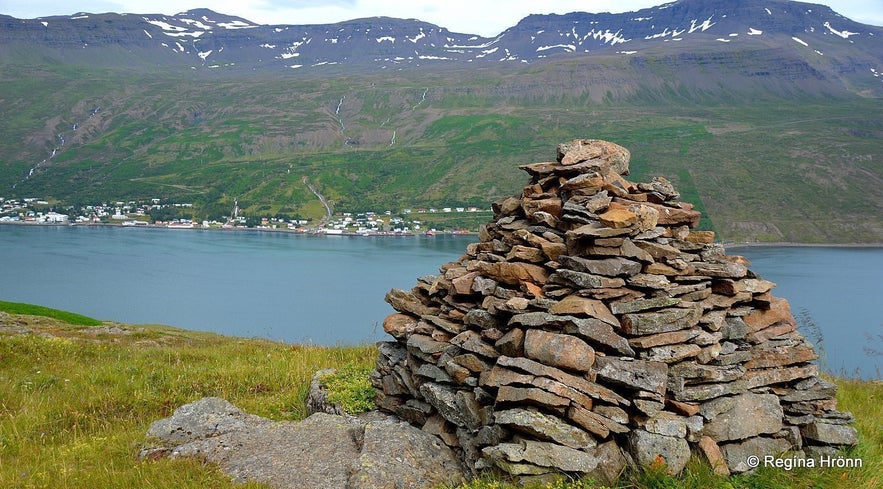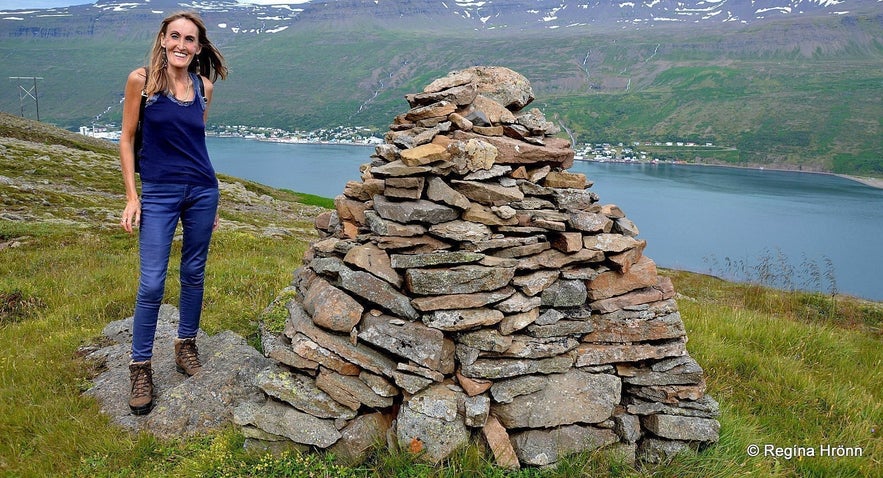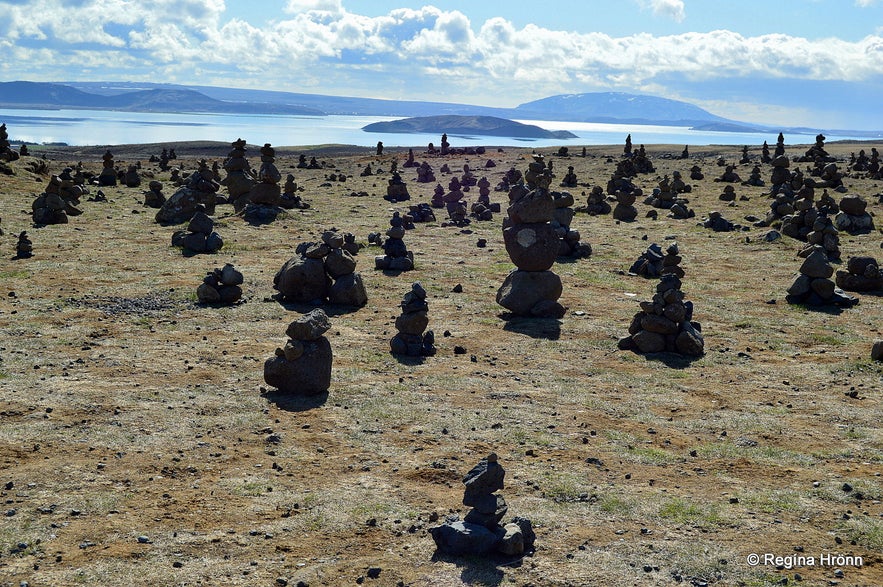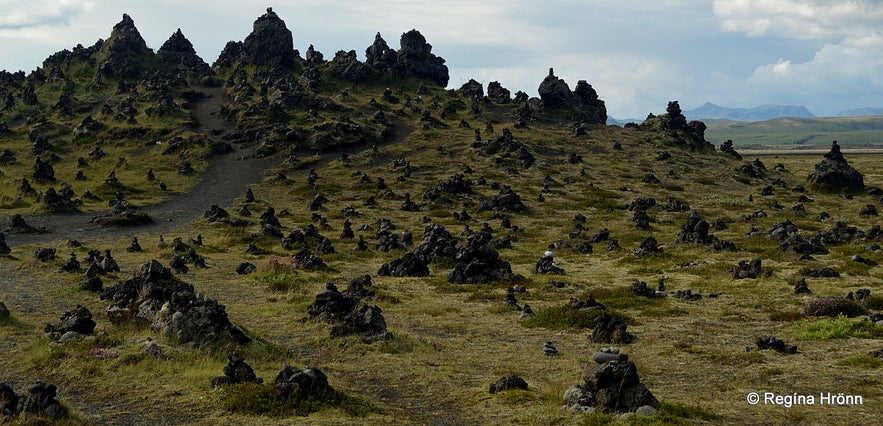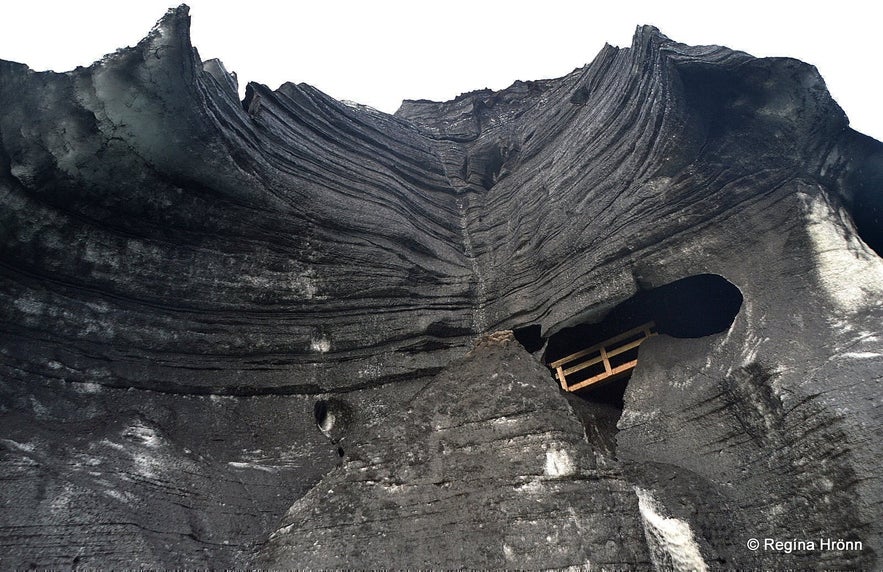
The Old Tradition of Creating Stone Cairns in Iceland


We have an old tradition in Iceland of creating stone cairns to show the way. These old stone cairns acted as beacons for people travelling in Iceland, a kind of GPS system of the olden days. Nowadays some visitors in my country are stacking new stone piles all over the country and this is making us Icelanders very concerned.
I don't think that our foreign visitors, who make these stone piles, realize how much damage they are doing and that Iceland is getting inundated with small stone piles all over the country. This is a universal problem as I have seen these stacks of stones in so many places on my travels abroad.
Top photo: An old cairn on the heath leading from Hænuvík to Kollsvík in the Westfjords of Iceland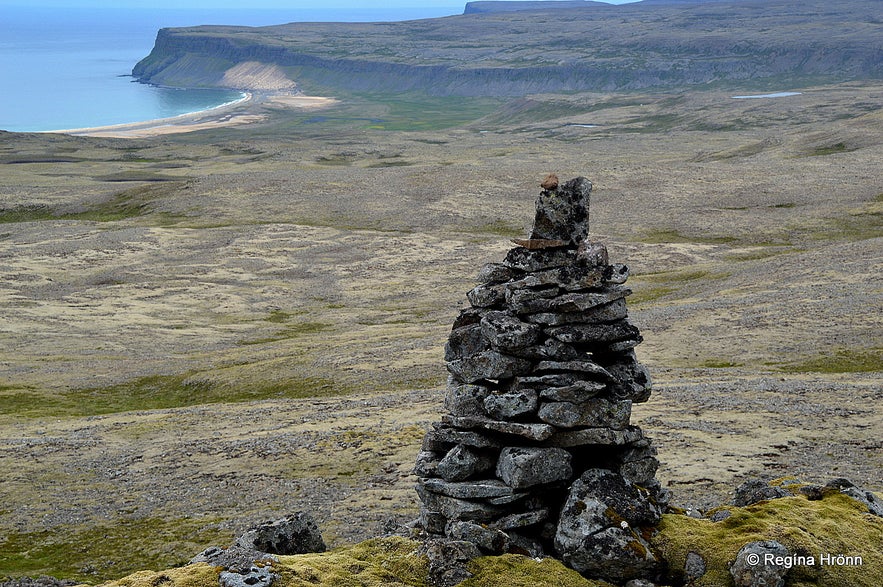
An old cairn close to Látrabjarg in the Westfjords
I know that this is a statement like "I was here" and is kind of cute, but with so many people visiting Iceland, this has become so damaging to our nature and we locals must kindly ask you travellers in our country to stop leaving such stone piles behind.
Icelanders have erected stone cairns since the settlement of my country in the 9th century when the Viking settlers made cairns as landmarks on their expeditions. You can see such cairns in different locations all around Iceland. 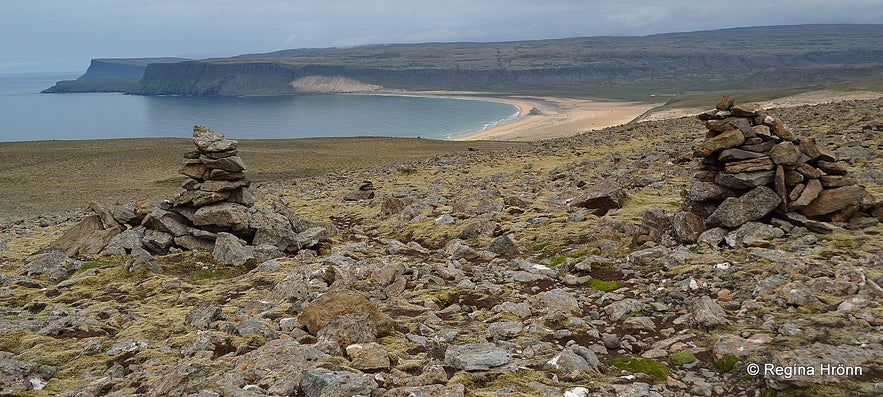
Old cairns in the Westfjords
These old cairns are protected and are never to be tampered with. We don't know the age of many of these cairns, but one of the cairns in the Westfjords is even considered to be the oldest structure in Iceland and is believed to have been erected in 871 by Hrafna-Flók - Raven-Flóki.
Hrafna-Flóki was the one who gave Iceland its name when he saw drift ice floating around.
This custom of erecting cairns could have come with the Irish slaves, which the Vikings brought with them when they settled Iceland, as such cairns can also be seen in Celtic areas. But that is just a guess on my behalf.
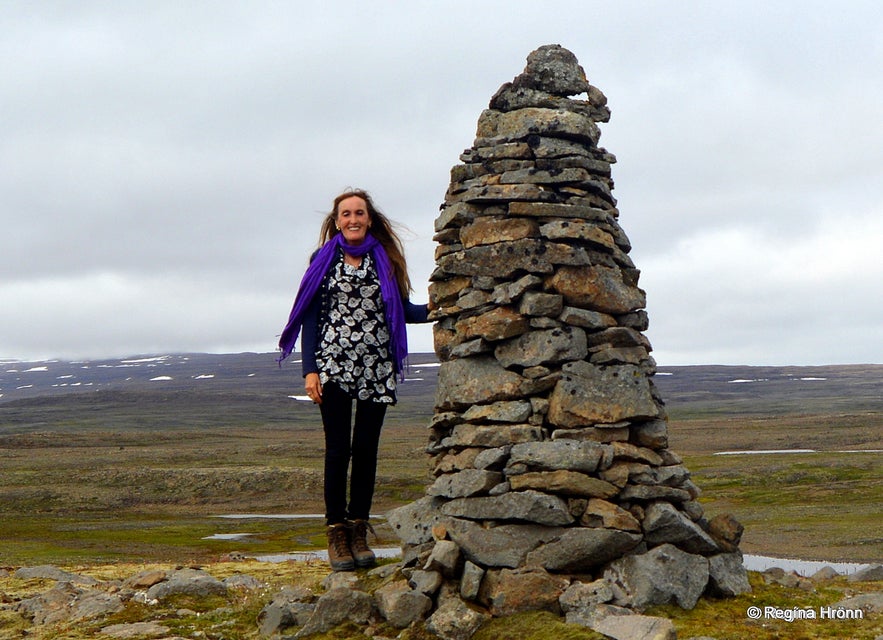 An old tall cairn on Þorskafjarðarheiði heath in the Westfjords
An old tall cairn on Þorskafjarðarheiði heath in the Westfjords
The cairns can be both big and small, as you can see in the photos above and below, of some of the cairns I saw on Þorskafjarðarheiði heath (Route 608) in the Westfjords.
The cairn in the photo above is one of the largest ones I have seen on my travels in my country. Opposite the big cairn was this small one in my photo below.
It was the duty of each traveller in the old days to erect a small cairn when passing the Þorskafjarðaheiði heath for the first time. Thus your journey across the heath would be without mishap from then on.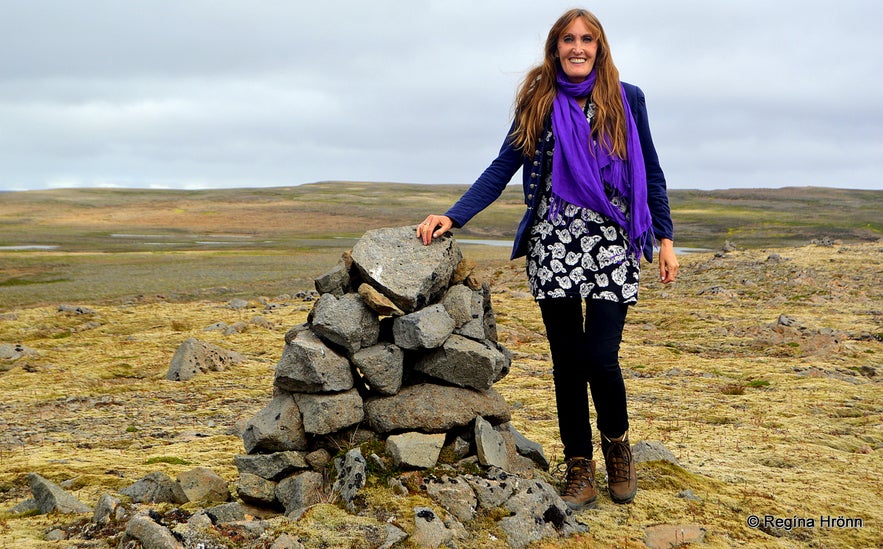
An old small cairn on Þorskafjarðarheiði heath in the Westfjords
The original cairns were made by the Vikings when they went on their explorations of Iceland. They had to be able to find their way back and to lead the way for others through the highlands and across the heaths. Iceland was new to them and they had no idea what to expect on their expeditions.
These cairns can still be used as landmarks and pathfinders, so adding new ones could be very harmful and could make somebody lose his way and lead him into trouble. And I know that nobody wants to be responsible for making a person lose his way in fog or bad weather on a heath in Iceland. 
Old cairns on Látraheiði heath
I saw a great number of small cairns on Látraheiði heath in the Westfjords. These cairns were erected a very long time ago, but back then it was a tradition to erect a small cairn for your protection for the first time you passed this heath at Brunnahæð hill.
It was considered your duty to erect a small cairn or 3 of them; 3 rocks on top of each other f.ex.
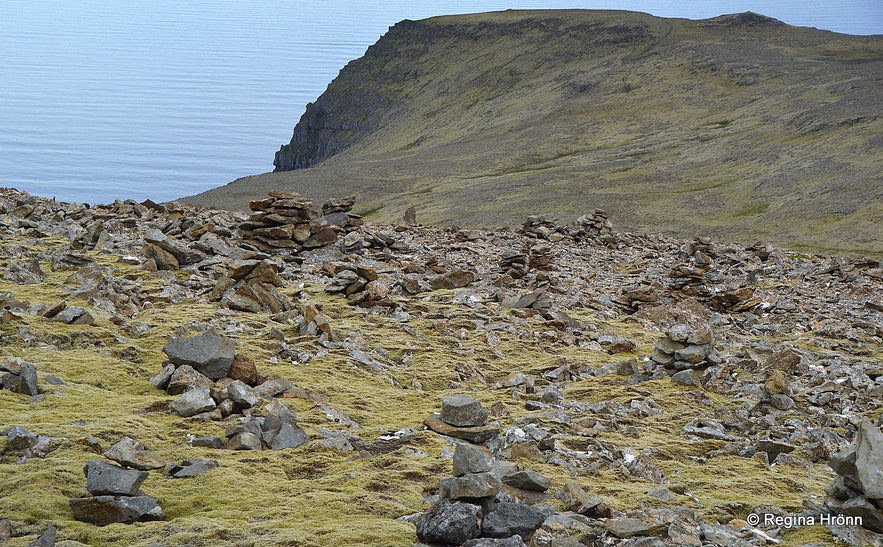
Old cairns on Látraheiði heath
This was done for your protection and the protection of other travellers, as here it was easy to lose your way.
Fog was common here and bad weather and nobody wanted to be caught in fog so close to the sea and so high above sea level. So the cairns were a warning sign as well as a GPS system.
(Information from the book Álög og bannhelgi by Árna Óla - Þórður Jónsson, Látrum - 1958).
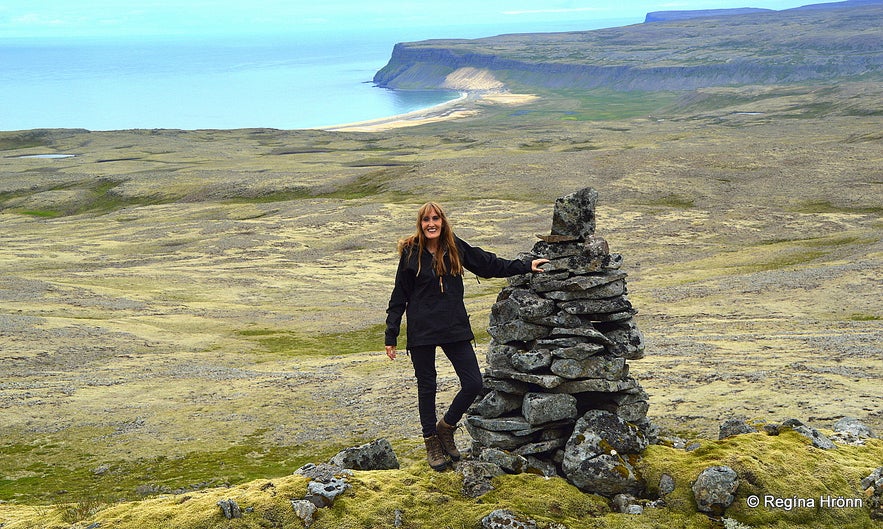
A big old cairn between Látrabjarg and Keflavík in the Westfjords
As time went by people started travelling more on the highland routes and in the year 1831, some 100 new cairns were erected on Holtavörðuheiði heath. At the turn of the century, more and more trails were marked with cairns.
In the mid-19th century, these cairns in my photo below were erected, but they showed the way from Mývatn to Vopnafjörður if I am not mistaken. These ones in my photo below I saw by ring-road 1 close to the Dettifoss route.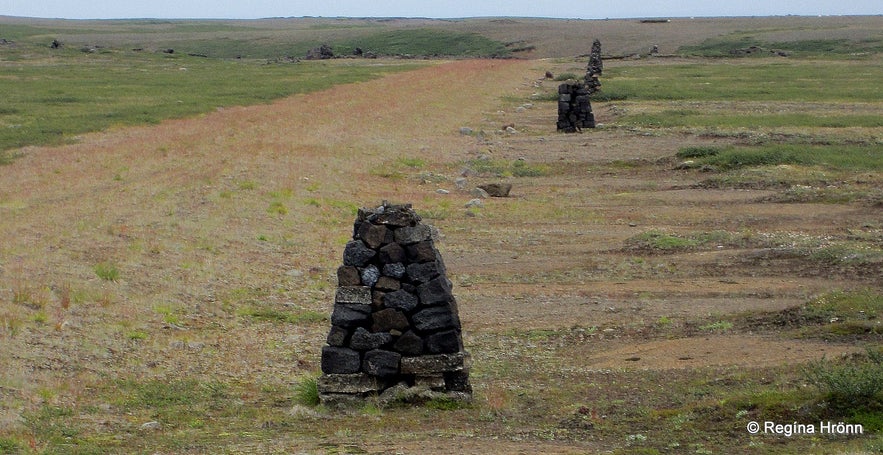
Old cairns between Mývatn and Jökulsárgljúfur canyon
Most of the cairns were used as the GPS of our time through the heaths and wilderness, but you will see other cairns in Iceland which were erected to show boundaries and signs of some sort and some were stacked on top of burial mounds.
I have shown you such burial mounds f.ex. in my travel-blog about the grave of Hjörleifur on top of Hjörleifshöfði in South Iceland - see my photo below.
Hjörleifur was Iceland's second settler and was killed by his Irish slaves one year after he arrived in Iceland.
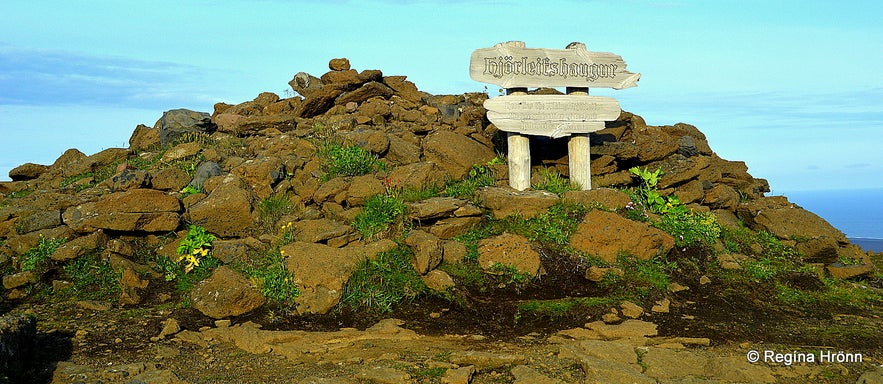 Hjörleifshaugur burial mound on top of Hjörleifshöfði in South-Iceland
Hjörleifshaugur burial mound on top of Hjörleifshöfði in South-Iceland
Another ancient burial mound is to be found at the second northernmost location on the mainland of Iceland, Hraunhafnartangi spit. It is called Þorgeirsdys - the Burial Mound of Þorgeir Hávarsson, a Viking Age warrior.
Þorgeirsdys is mentioned in the Saga of Sworn-Brothers (Fóstbræðrasaga). Þorgeir defended himself against his enemies and killed 14 of them. Þorgeir's torso is said to be buried in the burial mound. He was beheaded by his enemies and his head was carried as proof of the victory to Eyjafjörður, where it was eventually buried. 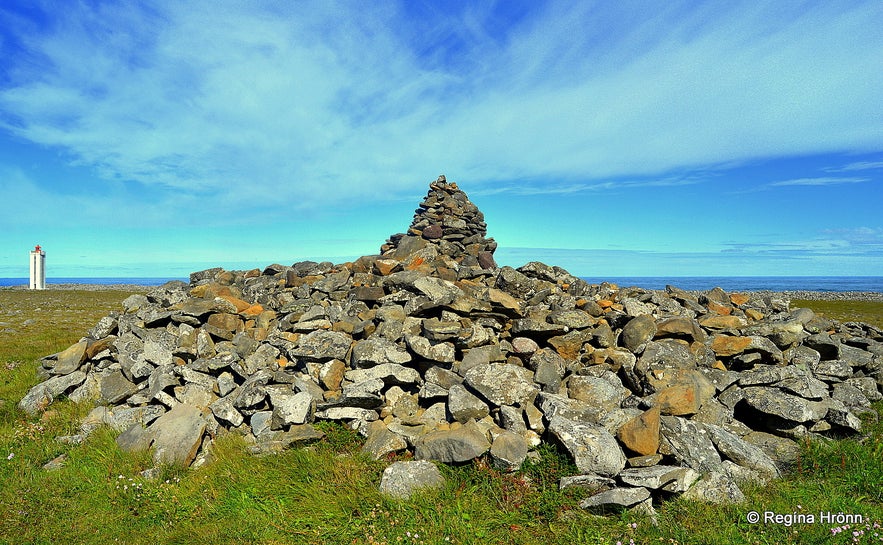
Þorgeirsdys burial mound at Hraunhafnartangi spit
His enemies made a game of putting the head on top of tussocks and mocking it. But as they did so in Eyjafjörður they became afraid of the head, which had the eyes wide open and the mouth open with the tongue falling out. Thus they buried the head (as told in the 20th chapter of the Saga of Sworn-Brothers).
The other victims of this Viking battle are also said to be buried in Þorgeirsdys burial mound.
An ancient custom as a way to greet the "dweller of the burial mound" was to throw a stone onto the burial mound. People were to walk clockwise around the burial mound while contemplating and wishing others well.

I climbed on top of the burial mound to show you how big it is - I should not have though as it is protected
You can read more about the second northernmost spot on the mainland of Iceland in my travel-blog:
Hraunhafnartangi in North Iceland - one of the Northernmost Spots on the Mainland of Iceland
In Iceland, you will find cairns that mark the spot of the burial mounds of prophetesses. One such burial mound can be found in East Iceland. It is called Völvuleiðið á Hólmahálsi - the Burial mound of the Prophetess at Hólmaháls.
Völvuleiðið á Hólmahálsi - the Burial mound of the Prophetess at Hólmaháls East-Iceland
This burial mound is located at Hólmaháls between Reyðarfjörður and Eskifjörður in East Iceland. The Prophetess in question is now the protector of this area. I found the story of the prophetess in Þjóðsögur Jóns Árnasonar - the Collection of Folklore by Jón Árnason volume IV - page 124:
"Once upon a time there was a prophetess; she was very wise. It is not mentioned where she lived, but before she died, she asked to be buried in Reyðarfjörður, from where there was the best view of the sea - she said that pirates would not be able to conquer Reyðarfjörður while her grave was visible.
She was buried on the spit leading from Hólmatindur and which is called Hólmanes. It splits the main fjord into Reyðarfjörður and Eskjufjörður; it is high up and the view from there toward the sea is ideal. The thoroughfare leads through here and the grave is right by it; it looks like a green tussock.
Völvuleiðið á Hólmahálsi - the Burial mound of the Prophetess at Hólmaháls East-Iceland
Pirates sailed their ships here and meant to reach Reyðarfjörður; but as they arrived at the mouth of the fjord it appeared to them as if the whole fjord and land were on fire and they were forced to leave (this was maybe in 1627 when pirates came ashore in Djúpavogur and the Westman islands); the prophetess was thanked for this."
(Þjóðsögur Jóns Árnasonar - the Collection of Folklore by Jón Árnason volume IV - page 124).
So you see that the cairns in Iceland mean something and are an important part of our history. Cairns were sometimes erected in remembrance of people or incidents. Others were erected to show the time and good fishing spots f.ex.
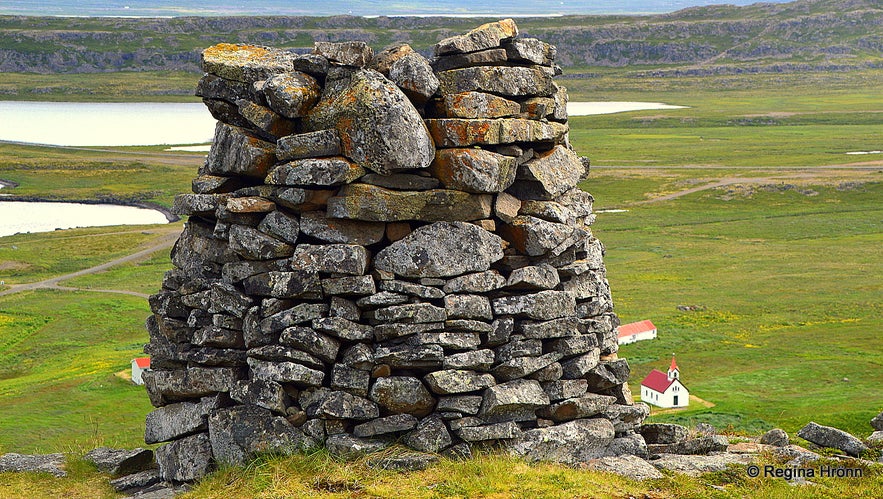
Grettisvarða cairn in Vatnsfjörður in the Westfjords
In the historical Vatnsfjörður on the northern side of the Westfjords of Iceland, you will find a huge cairn called Grettisvarða cairn. The Viking outlaw, Grettir Ásmundarsonar, a.k.a Grettir the Strong, might have built this cairn.
The rocks in the cairn are huge, so a real strong man or men have built it. It can also have been a watchtower as it is hollow from the middle up.
See more in my travel-blog: Vatnsfjörður in the Westfjords of Iceland - the Viking Estate and Grettisvarða Cairn
Grettisvarða cairn is huge
Then there is another type of cairns, the so-called beinakerling or Bone crone, where travellers were to compose a verse and leave it in a leg bone of a sheep or a cow and leave it for the next traveller to read.
These cairns were made to be the personification of women or maybe it is better to say courtesans, and the verses were supposed to be a message from the Bone crone to the next traveller.
Some of these verses were of a lewd and naughty nature - I guess that men of all times have been the same ;)
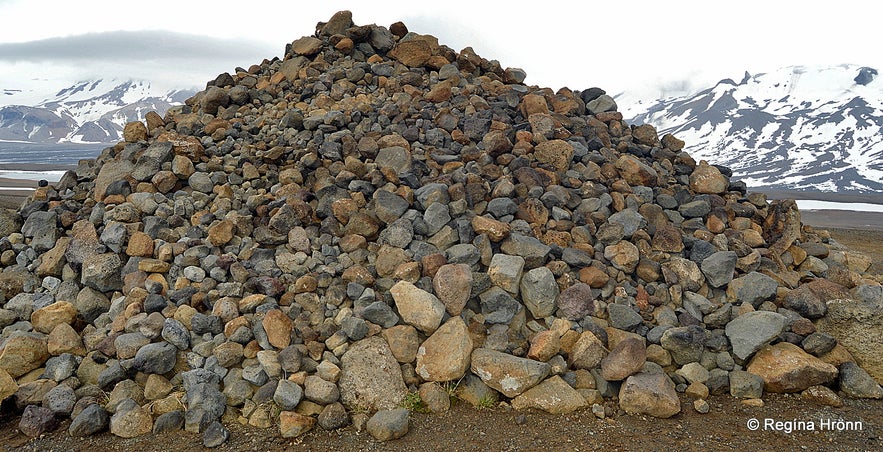
The stone pile on the Kaldidalur route
I have seen heaps of stones in some places, f.ex. on the Kaldidalur route and Kjölur route. This pile of rock in my photo above is located on the highest point on the Kaldidalur route, on Langahryggur, which is 727 m above sea level.
One of the best-known verses related to the Bone crone at Kaldidalur (which is in another location - I add the photo above as I don't have a photo of the Bone crone) goes like this:
"Sækir að mér sveina val
sem þeir væri óðir,
kúri ég ein á Kaldadal,
komi þið, piltar góðir"
Which translated into English goes something like this:
"I am inundated with a selection of boys
who seek me like they were mad
I am cuddled up alone in Kaldidalur
you are welcome to join me, dear boys"
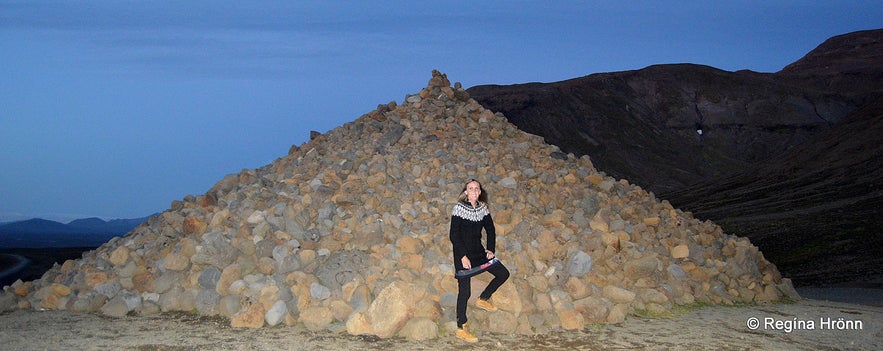 The stone pile on the Kjölur route in the dusk
The stone pile on the Kjölur route in the dusk
The huge stone pile on the Kjölur route is located by the road at Bláfellsháls.
It is allowed to add to these stone piles and the piles are getting bigger and bigger now that more and more travellers are visiting the highland routes.
You will see another such pile, not as big though, in Hamarsfjörður in East Iceland. It is called Djáknadys - the Deacon's burial mound.
Djáknadys burial mound
Here, according to legend, the deacon of Hamar and the pastor of Háls fought to their death - the reason for their quarrelling is not known.
The deacon and the pastor were both buried here and the burial mound is called Djáknadys or Deacon's burial mound.
When you first passed by Djáknadys, it was traditionary to throw a stone onto the mound, so you would not lose your way
Djáknadys burial mound
Djáknadys is well marked with an information sign and 2 signs showing that this site is preserved.
For more information in Icelandic and English check out the website of Minjastofnun - The Cultural Heritage Agency of Iceland: Djáknadys.
I must also mention 9 other cairns, which you might want to pay a visit to. They are the cairns from the Saga of Egill Skallagrímsson.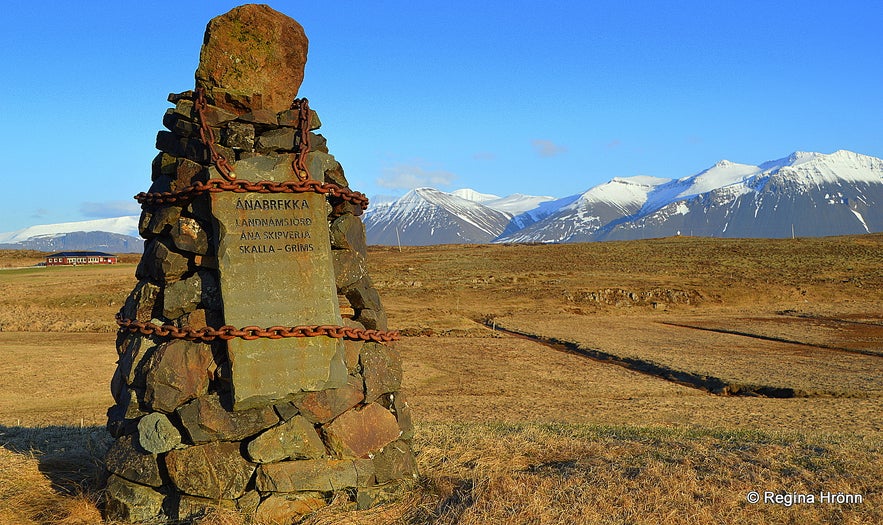
The cairn at Ánabrekka in West-Iceland
The curators of the Settlement Centre in Borgarnes have erected these cairns to mark historical locations from the Saga of Egill, which depicts the story of the settlers of this area in West Iceland; Skalla-Grímur Kveldúlfsson and his son Egill.
You can go on a treasure hunt and locate all these 9 cairns. I went on such a treasure hunt and looked for the cairns. I didn't do so in one go, but every time I visited West Iceland I would go look for a cairn or two.
Some of them are located by the road but it takes some doing to locate a couple of them.

Borg á Mýrum in West-Iceland
One of the cairns is located at Borg, where Egill Skallagrímsson lived.
You can get a map of them at the Settlement Museum or just follow my travel-blog with photos and locations of all these cairns.
There is yet another huge cairn in the Westfjords which serves as a monument - the Kleifabúi stone man.

Greeting Kleifabúi - see how tall it is!
There is a huge cairn - a stone man called Kleifabúi on Kleifaheiði heath in the Westfjords. It was erected in 1947 by the road construction workers who were working in this area. It is for sure the biggest cairn erected in Iceland, but it is more of a statue than a cairn really as it has got a cement head.
I tell you the whole story about why it was erected in my travel-blog: The Stone-men in the Westfjords - Kleifabúi on Kleifaheiði and the Stone-man by Penna.
Tourist cairns in Iceland
Tourist cairns or warts as they are sometimes called - these cairns have now been removed
Now let's get back to the new cairns or stone piles. I gather that not many people travelling in Iceland want to see mementoes from other travellers, which they have left behind as an "I was here" sign.
I get so sad when I see these stone piles - we travel around Iceland to enjoy the unspoiled nature and to replenish our body and spirit - and then we encounter a stone pile - it has the same effect on us as coming across pointless graffiti or litter in our country.
This has mushroomed with more travellers visiting Iceland, and now we don't seem to be able to go anywhere without encountering these stone piles. The tourist cairns in my photo above mushroomed at the viewpoint of Þingvallavatn lake, but they have now been removed.
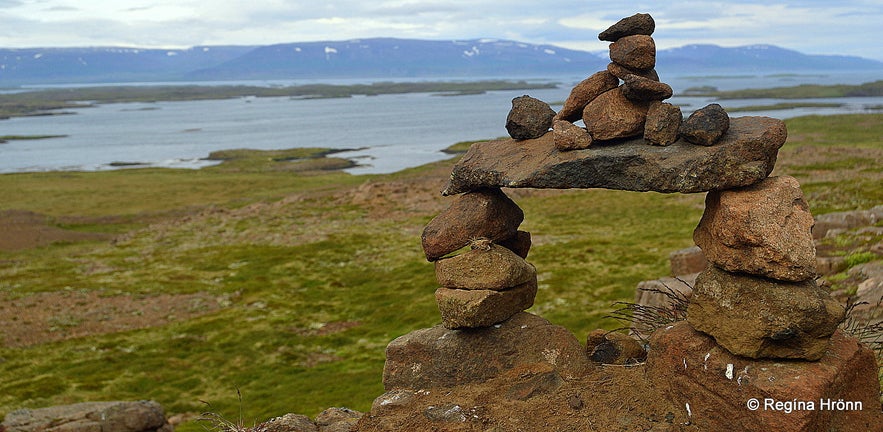
A tourist cairn in Snæfellsnes in West Iceland :(
I even encountered this "work of art" on my travels on the Snæfellsnes peninsula - see my photo above. I dismantled it as I do with every stone pile I encounter.
The worst case of a stone pile I have seen is when we were driving through Eldhraun lava field in South Iceland by ring-road 1 and stopped to enjoy this area. Only to see that somebody had made a pile out of lava rocks (photo below), leaving behind big scars in the moss.
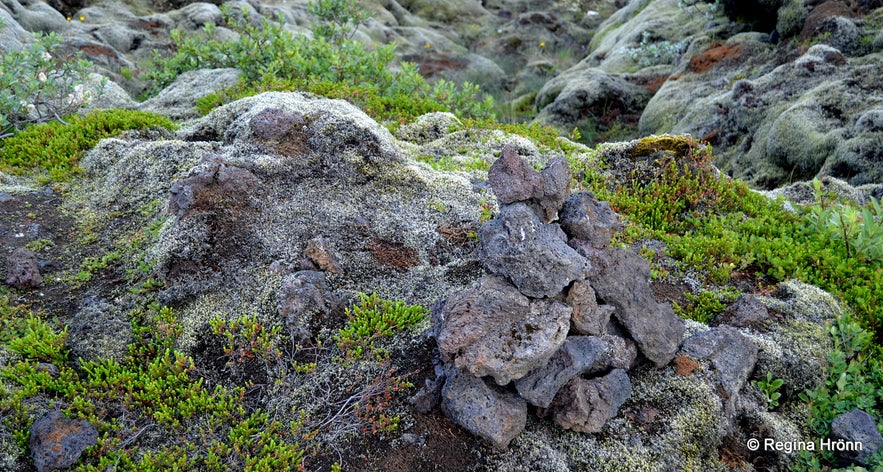 A tourist cairn in South Iceland :(
A tourist cairn in South Iceland :(
I was reduced to tears and tried my best in putting the lava rocks in their original place, but the damage had already been done :(
This is damage to Icelandic nature, and I am sure that the travellers, who erected this lava pile, didn't realize what they were doing. They must have thought that this was only a cute reminder of their visit to Iceland, but the long-term effect of this is damage to Icelandic nature.
That is why I am writing this travel-blog to point out how damaging this is on such a large scale as we are experiencing in Iceland.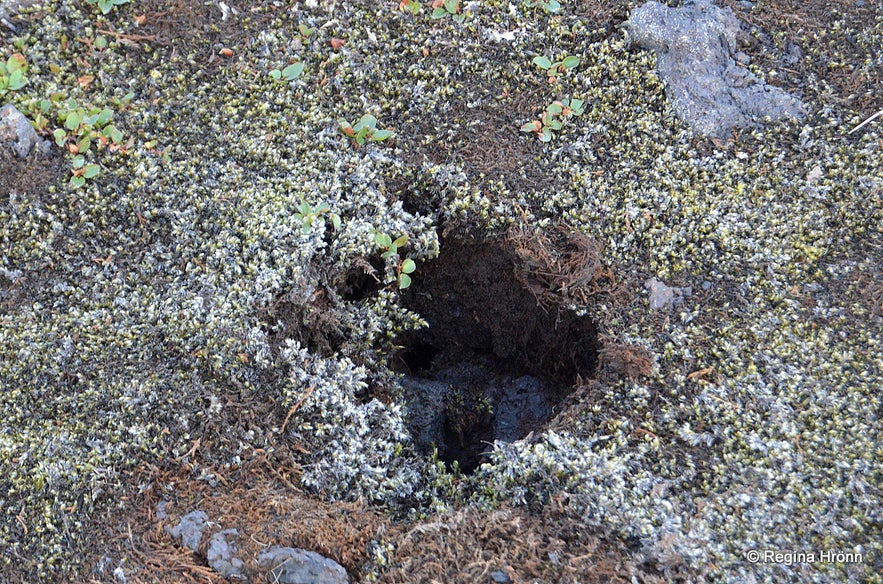
One of the scars in the moss left after a tourist created a tourist cairn in South Iceland :(
Where ever I see these stone stacks I dismantle them, or if they are small enough I give them a nudge so they get dismantled. All tour guides in Iceland have been advised to do the same. Please, let's end this and keep nature untouched for us all to enjoy!
Let's remember the leave-no-trace ethics. Only take photos and leave nothing behind but footsteps in nature. Please help us Icelanders to keep our nature as unspoiled as possible.
A tourist cairn en route to Kaldidalur :(
Code number four on the Environmental Agency of Iceland’s Traveller’s Code reads: “Never dislodge stones or build cairns.” Let's respect this rule so that my country won't be full of scars.
Here is an article in Iceland Review - Rangers remove tourist warts.
Laufskálavarða
Laufskálavarða
One of the locations where cairns were erected in Iceland for good luck was at Laufskálavarða in South Iceland. Almost at the very end of Mýrdalssandur vast glacial outwash driving east, you will notice a sudden change in the landscape; a field of countless small stone cairns opens up - this is Laufskálavarða - the Cairn of Laufskálar.
In the old days traditionally everybody passing by Laufskálavarða for the first time added a stone to a cairn at Laufskálavarða for good fortune on their journey through this dangerous area. What makes this area dangerous are the massive glacial floods which take place here from time to time.
These stone cairns have piled up for the past millennia.
Laufskálavarða
The Icelandic Road Administration saw to it that there was always a good supply of rocks so that first-time travellers could build their own small cairn for luck. This old tradition no longer applies.
An information sign by the car park tells you about this area and the dreaded Katla volcano.
If you look further up north then you will see Mýrdalsjökull and Kötlujökull glaciers.
The name Laufskálavarða derives from the big Viking farm Laufskálar, which was located in the vicinity but was destroyed in a Katla eruption in 894, which is the first recorded eruption in Katla after the Settlement of Iceland in around year 874. 
Laufskálavarða
The story goes that there were 24 doors on iron hinges on the Laufskálar farm, so just imagine how big this Viking farm must have been! A lava ridge was formed in the volcanic eruption and got the name Laufskálavarða or the Cairn of Laufskálar.
On the neighbouring farm to Laufskálar farm, Dynskógar, the great Viking settler Hrafn hafnarlykill lived. Landnámabók - the Book of Settlement of Iceland - tells us that Hrafn moved his farm to Lágey because of the volcano. When the Vikings settled in Iceland they did not know about the dangers lurking in this area.
The same happened at Hjörleifshöfði promontory in South Iceland, where the old farm was moved up on the promontory for safety from the massive glacial outburst floods.
Parts of Kötlujökull - the Katla glacier
North of Laufskálavarða cairn Katla is lurking beneath the 560 sq. km ice cap of Mýrdalsjökull glacier, waiting to spew out its lava and ash clouds.
The Katla volcano is one of Iceland's most notorious and dangerous volcanoes and the one we are all scared of.
We Icelanders are brought up to fear this volcano as the Katla eruptions are among the biggest cataclysms in Iceland.
The Katla ice cave in South-Iceland
Again I must reiterate that the reason for me to write this travel-blog is to both tell you about our old cairns and to kindly ask you to help us Icelanders keep our nature intact by not stacking any more stone piles so that we can all enjoy Icelandic nature for years to come.
Have a lovely time in Iceland :)
Inne ciekawe blogi
Gorące źródła - Hrunalaug
Z czego słynie Islandia? Zorza polarna, wulkany, lodowce, gejzery i oczywiście gorące źródła! Hruni, a właściwie Hrunalaug to gorące źródło w malowniczym otoczeniu, znajdujące się w w pobliżu miejscowCzytaj więcejPolowanie na Zorzę
Zobaczenie zorzy polarnej to marzenie wielu osób. Zorza jest dla mnie czymś magicznym i niepowtarzalnym, zachwyca mnie za każdym razem. Czy faktycznie tak ciężko ją dostrzec? Otóż nauczyłam się, że niCzytaj więcejO pisaniu na Guide to Iceland
Mam wrażenie, że na Islandii bardzo wiele rzeczy staje się jasnych. Chodzi o podejście do świata, do własnej osoby, do innych, którzy realnie wpływają na Twoje życie. Islandia zmusza swoją surowościCzytaj więcej

Pobierz największą platformę turystyczną na Islandii na telefon i zarządzaj wszystkimi elementami swojej podróży w jednym miejscu
Zeskanuj ten kod QR za pomocą aparatu w telefonie i naciśnij wyświetlony link, aby uzyskać dostęp do największej platformy turystycznej na Islandii. Wprowadź swój numer telefonu lub adres e-mail, aby otrzymać wiadomość SMS lub e-mail z linkiem do pobrania.
